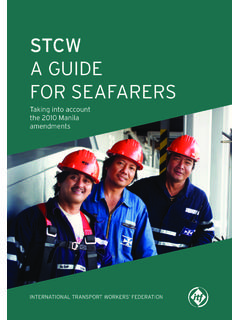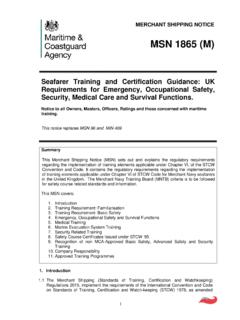Transcription of A GUIDE FOR SEAFARERS
1 STCWA GUIDE FOR SEAFARERST aking into account the 2010 Manila amendmentsINTERNATIONAL TRANSPORT WORKERS FEDERATIONF orewordIn June 2010 a diplomatic conference in Manila adopted a set of far-reaching andcomprehensive amendments to the 1978 International convention on Training,Certification and Watchkeeping for SEAFARERS known to us all more conveniently asthe stcw convention and its associated Code. This instrument has been described asone for the four pillars of the global maritime regulatory system, along with two otherIMO Conventions, SOLAS and MARPOL, and ILO s Maritime Labour convention .
2 Theamendments adopted mark the first major revision of the instrument since thoseadopted in 1995, which completely revised the original 1978 stcw shipping industry depends on competent, well-trained SEAFARERS to ensure safetyof life at sea, maritime security, efficiency of navigation and protection andpreservation of the marine environment. The revised stcw convention aims toprovide the international standards necessary for training institutes and trainers todevelop the much-needed skills and competencies for today s ITF has produced this guidance to help SEAFARERS understand the revisions andlocate the information that is of most relevance to them.
3 I support this effort to makethe convention requirements accessible to all and trust that this GUIDE will support theachievement of the objectives of the stcw convention and SekimizuSecretary-General, IMOSTCW: A GUIDE FOR SEAFARERS3 INTERNATIONAL TRANSPORT WORKERS FEDERATIONC ontents About this guide7 Section 1:The stcw convention 11 Layout of the convention 12 Deadlines to meet 13 Glossary of terms 14 Additional definitions and requirements of the amended stcw Convention16 Section 2:Certification requirements 17 Part 1 stcw certificates Certificates 18 Certification paths 22 General requirements for officers 24 General requirements for ratings 26 Part 2 Certificates and general requirements by rank Master 29 Chief mate 30 Officer in charge of a navigational watch 31 Ratings forming part of a navigational watch33 Able seafarer deck34 Radio operators35 Chief engineer36 Second engineer37 Officer in charge of an engineering watch38 Electro-technical officer39 Ratings forming part of an engineering watch 40 Able seafarer engine 41 Electro-technical
4 Ratings 42 Any other crew member 43 Part 3 Other certificates For personnel on any type of ship Additional non mandatory training44 For personnel on tankers 46 For personnel on passenger ships 47 Part 4 Training issues Education and training issues 48 Simulator training under stcw 49 English language requirements 49 stcw : A GUIDE FOR SEAFARERS5 INTERNATIONAL TRANSPORT WORKERS FEDERATIONThe use of distance learning and e-learning 49 Onboard training and assessment 49 Responsibilities of companies 50 Implementation of the ISM code relevant to stcw 50 GMDSS (global maritime distress and safety system) certificates 50 Medical fitness standards51 Section 3.
5 On board requirements 54 Certificates and documentary evidence to be carried on board 54 Mandatory safety and ship-board familiarisation training 56On-board training and assessment 58 Seagoing service 59 Alcohol and drug consumption60 Control provisions 61 Penalties 63 Regulations affecting watch-keeping personnel duty 64 Section 4:Implications of amendments to stcw holders 67 Upgrading and revalidation 68 Additional competence requirements under 2010 STCW69 Master and deck department 69 Engine department 70 Section 5:Where to find more information on STCW74 Annex AList of countries party to STCW75 Annex BIMO circular ( ) on guidance for port state76control inspectors in respect of certificates of competenceissued under the provisions of the stcw convention Annex CSummary of requirements78 stcw : A GUIDE FOR SEAFARERS6 INTERNATIONAL TRANSPORT WORKERS FEDERATIONSTCW: A GUIDE FOR SEAFARERS7 INTERNATIONAL TRANSPORT WORKERS FEDERATIONA bout this guideThis GUIDE is aimed at SEAFARERS of all ranks and nationalities.
6 Its main purpose is tohelp you find out how the 2010 Manila amendments to the stcw will affect we have tried to make this GUIDE as accurate as possible, you should contactthe maritime Administration issuing your certificate(s) of competency andendorsement(s) for specific information on the national requirements and deadlinesyou must 1 gives background information on the amended stcw convention , includingdeadlines to meet, and provides a brief glossary of 2 outlines the certificates you need to hold before signing on a ship in order to ensure that you comply with the amended stcw .
7 This section consists of four 1 tells you about stcw certificates, certification paths and general requirementsfor officers and ratings. Part 2 lists the certificates and general requirementsdemanded according to rank. Part 3 tells you what certificates you need, depending on your function on board and the type of vessel you are working on. Part 4 givesguidance on training establishments, simulator requirements, English language andGMDSS 3 deals with the requirements you need to meet once you are on board. This includes what documentation you must have with you at all times, ship-specificfamiliarisation training, training records and sea-going service.
8 It also covers theregulations on alcohol and drug consumption, control procedures and penalties. There is also a section applying to watch-keeping personnel only, officers and ratings,on rest hour regulations and watch-keeping 4 tells you what you need to do to if you are a holder of an stcw -95certificate and need to update your certificate to 2010 amended stcw . This sectionincludes tables that summarise by rank the additional competencies you need todemonstrate to upgrade your , Section 5 lists other sources of information you can consult should you want to know more about the 2010 amended GUIDE is produced by the International Transport Workers Federation (ITF).
9 You can also download a free version from our website at : A GUIDE FOR SEAFARERS8 INTERNATIONAL TRANSPORT WORKERS FEDERATIONS ection 1: stcw ConventionSTCW: A GUIDE FOR SEAFARERS10 INTERNATIONAL TRANSPORT WORKERS FEDERATIONThe stcw ConventionThe key to maintaining a safe shipping environment and keeping our oceans clean liesin all SEAFARERS across the world observing high standards of competence andprofessionalism in the duties they perform on-board. The International convention onStandards of Training, Certification and Watchkeeping for SEAFARERS 1978, as amendedin 1995 and again in 2010 , sets those standards, governs the award of certificates andcontrols watchkeeping arrangements.
10 Its provisions not only apply to SEAFARERS , butalso to ship-owners, training establishments and national maritime convention was adopted by the International Maritime Organization (IMO) in 1978and came into force in 1984. During the late 1980s, it was clear that stcw -78 was notachieving its aim of raising professional standards worldwide, and so IMO membersdecided to amend it. This was done in the early 1990s, and the amended conventionwas then called 2010 Manila amendments was intended to include all agreed changes since 1995,address new technology, inconsistencies, interpretations and outdated was particular emphasis on improving control and communication provisions ofcertification in Chapter 1 and addressing the specific requirements of offshore andshort sea shipping.

